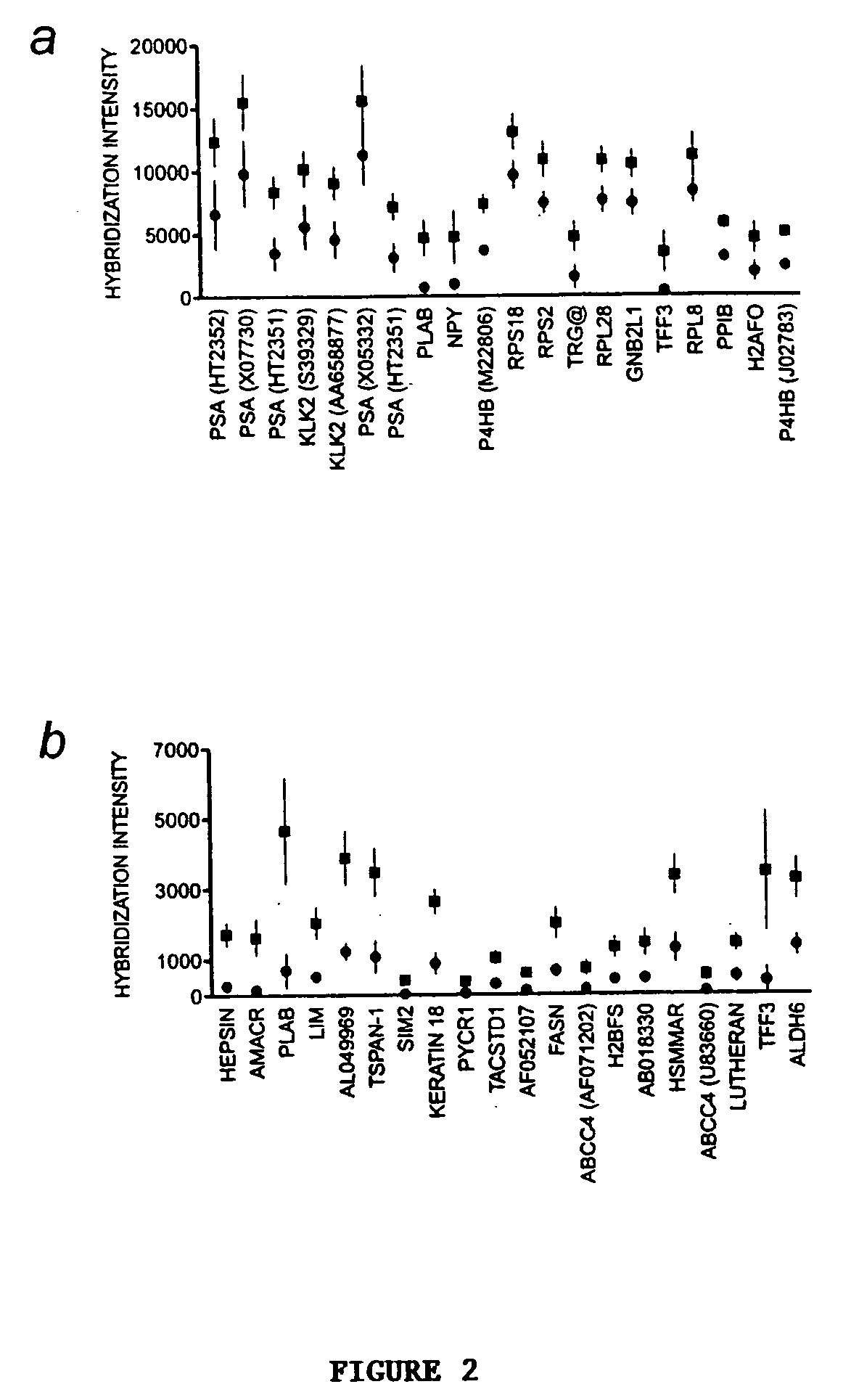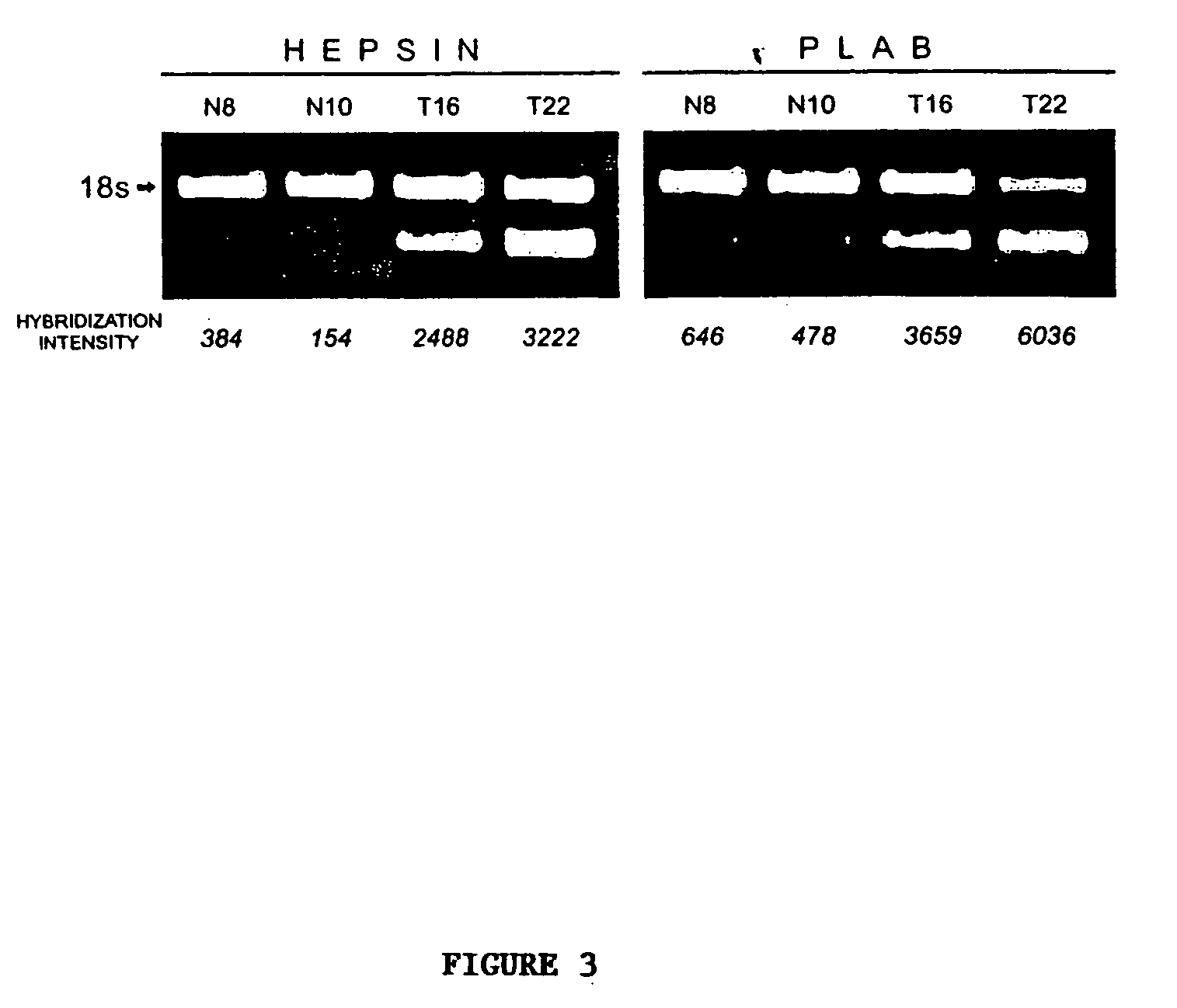Genes overexpressed in prostate disorders as diagnostic and therapeutic targets
a prostate disorder and gene overexpression technology, applied in the field of genes, can solve the problems of high false-positive rate for prostate cancer detection, insufficient expression of these genes to make statistically valid assessments of differential expression between normal and cancer tissue, and inability to improve the survival rate of men with prostate cancer, etc., to achieve the effect of reducing the expression level, inhibiting the proliferation of undesired prostate cells, and reducing the expression
- Summary
- Abstract
- Description
- Claims
- Application Information
AI Technical Summary
Benefits of technology
Problems solved by technology
Method used
Image
Examples
example 1
Gene Expression Profiles in Prostate Tissue Samples and Cell Lines
[0153] To test the hypothesis that gene expression profiles could be used to classify prostate tissue samples, the expression levels of genes in tissues and cells is monitored by hybridization of RNA samples to oligonucleotide microarrays representing approximately 8,920 different genes. In total, 55 RNA samples derived from 25 prostate cancer tissues (24 unique samples), nine nonmalignant prostate tissues, and 21 cell line samples of various origin (18 unique lines) (see Materials and Methods) are hybridized. The complete dataset is available on the web site (http: / / www.gnf.org / cancer / prostate).
[0154] To reveal distinctions between individual tissue samples and cells, a subset of 3,530 genes that have varied most across the samples is selected and grouped both the genes and the samples according to their overall similarities in levels of expression as described, e.g., in Eisen et al., Proc. Natl. Acad. Sci. USA, Vo...
example 2
Expression of Genes From Different Cell Types
[0156] Prostate cancer samples contain varying fractions of non-malignant epithelial cells, fibromuscular stroma, endothelium, and infiltrating immune cells. Representatives of these cell types are profiled to help resolve cell type-specific expression patterns. From among the 3,530 genes analyzed, four major clusters are identified for which expression levels were similar in some of the cells and tissues. One cluster contains genes whose expression is high in stromal cells grown in vitro and in normal prostate samples, which microscopically contain a significant amount of stroma (range, 10-50%). This cluster includes genes for the α1 and α2 subunits of collagen VI and the fibroblast growth factor receptor, Type 1 (FGF-R1), which are expressed predominantly in fibroblasts. The concordance of stromal genes by this approach is not complete, as other groups of stromal genes within the primary tissues are identified that are absent or expres...
example 3
Differences in Gene Expression Among Prostate Tumors
[0158] The apparent molecular similarity among prostate results from the initial analysis of 3,530 genes whose expression varied most across normal tissues, malignant tissues, and cell lines. To better estimate the extent of the similarity among prostate cancers, 788 of these genes are selected whose expression is inferred to be specific to the malignant cells (the list of genes and the criteria used to select them are available at our web site). Expression levels of this group of tumor-specific genes are used to select for a smaller group (n=277) that vary most significantly across the tumors in an attempt to magnify any potential taxonomy. Clustering of the data shows a dichotomy among the tumors, which is largely attributable to differential expression of a group of ribosomal genes. This division roughly corresponds to the tumors' degree of differentiation, with significantly higher Gleason scores (P<0.01) in the tumor samples ...
PUM
| Property | Measurement | Unit |
|---|---|---|
| Volume | aaaaa | aaaaa |
| Volume | aaaaa | aaaaa |
| Volume | aaaaa | aaaaa |
Abstract
Description
Claims
Application Information
 Login to View More
Login to View More - R&D
- Intellectual Property
- Life Sciences
- Materials
- Tech Scout
- Unparalleled Data Quality
- Higher Quality Content
- 60% Fewer Hallucinations
Browse by: Latest US Patents, China's latest patents, Technical Efficacy Thesaurus, Application Domain, Technology Topic, Popular Technical Reports.
© 2025 PatSnap. All rights reserved.Legal|Privacy policy|Modern Slavery Act Transparency Statement|Sitemap|About US| Contact US: help@patsnap.com



